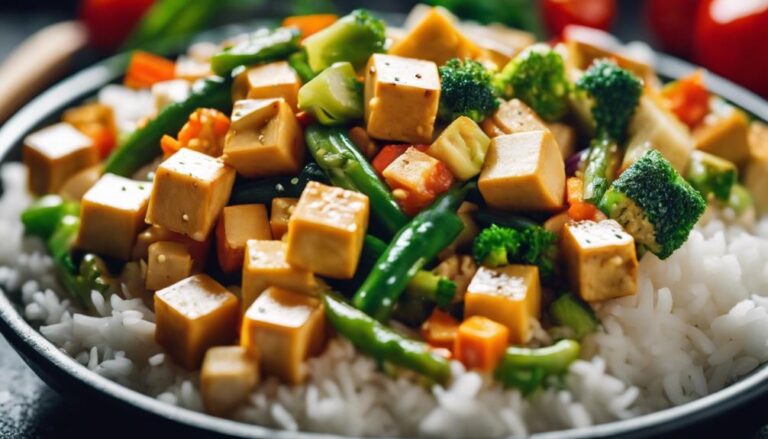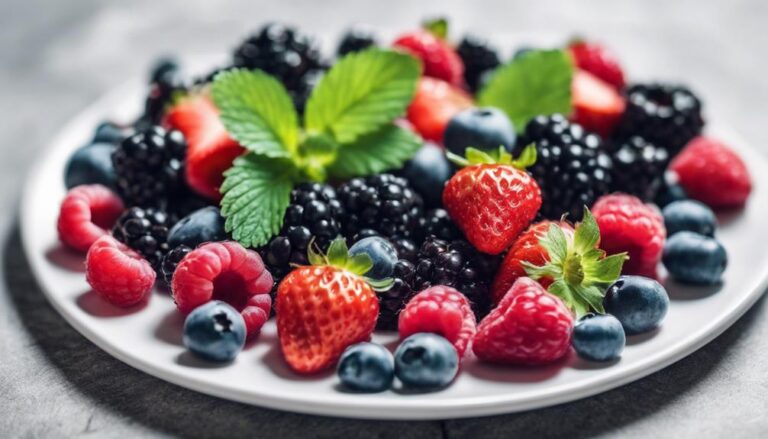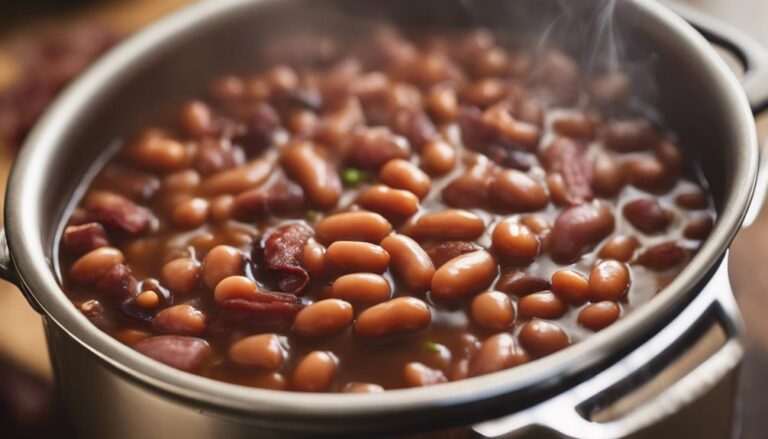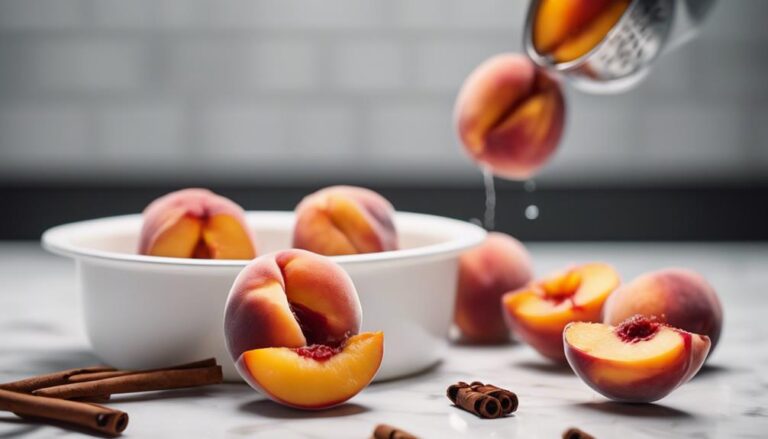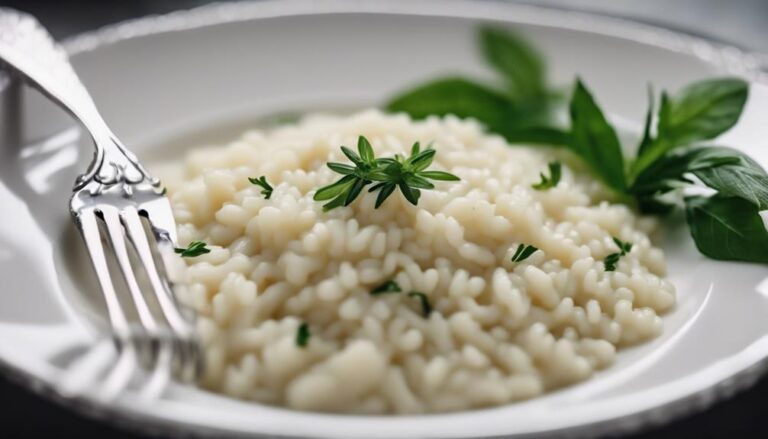Sous Vide Pork Tenderloin With Apple Glaze
Achieve culinary excellence with sous vide pork tenderloin and apple glaze. Seal pork with herbs like rosemary, thyme, and sage. Cook sous vide or roast for rich flavors. Sear for texture. The apple glaze balances sweet and savory tastes. Enjoy juicy, tender pork with a delightful contrast. Discover more about precision cooking and enhanced flavors.
What You Will Learn Here
- Sous vide pork tenderloin for juicy, tender results.
- Create apple glaze for sweet-tangy contrast.
- Ensure precise temperature control for consistent cooking.
- Infuse flavors with herb mixture before cooking.
- Retain natural juices and flavors with sous vide technique.
Sous Vide Origins
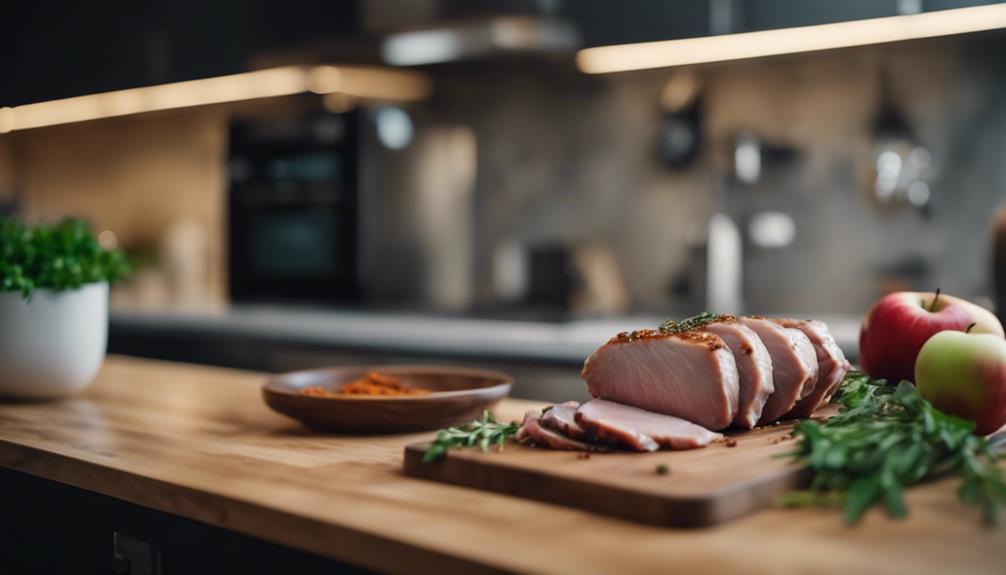
Sous Vide cooking is a method rooted in French culinary history. It involves sealing food in airtight bags and cooking it in a water bath at precise temperatures. The technique has gained popularity in recent years due to its ability to deliver consistently tender and flavorful results.
Sous Vide Cooking Technique
Originating in France, the sous vide cooking technique revolutionized the culinary world with its precise temperature control and ability to enhance flavors. Sous vide, which translates to 'under vacuum' in French, involves vacuum-sealing food in a bag and cooking it in a water bath at a precisely controlled temperature for an extended period. This method guarantees that the food cooks evenly and retains its moisture and natural flavors.
The sous vide cooking technique is renowned for its consistency in producing perfectly cooked dishes, whether it's a tender pork tenderloin or a delicate piece of fish. By cooking food at a constant low temperature for an extended time, sous vide helps break down tough connective tissues in meat while retaining its juices and tenderness.
One of the key benefits of sous vide cooking is the ability to infuse flavors into the food while it cooks. Because the ingredients are sealed in a bag, the flavors and seasonings intensify, resulting in a more flavorful end product. This precise cooking method has gained popularity among chefs and home cooks alike for its ability to deliver restaurant-quality dishes with minimal effort.
History of Sous Vide
The origins of the sous vide cooking technique can be traced back to the late 1960s in France. This method, which translates to 'under vacuum' in French, was developed by Georges Pralus and Bruno Goussault. Initially, sous vide was primarily used in industrial food preservation processes to maintain the quality of pre-cooked foods, but its application soon expanded to fine dining establishments.
Georges Pralus, a chef, experimented with vacuum-sealed bags to cook foie gras, discovering that this gentle cooking method resulted in enhanced flavors and textures while preserving the natural juices of the food. This breakthrough sparked interest among other chefs, leading to further innovations in sous vide cooking.
Bruno Goussault, a food scientist, played a significant role in refining the sous vide technique by studying the precise temperatures and cooking times needed to achieve excellent results. His research laid the foundation for the widespread adoption of sous vide in professional kitchens and eventually in home cooking.
Today, sous vide has become a popular culinary technique known for its ability to deliver consistently flavorful and tender dishes, making it a staple in modern gastronomy.
Benefits of Sous Vide
Experience the many advantages of utilizing the sous vide cooking method, from enhancing flavors to achieving precise doneness levels with ease. Sous vide, meaning 'under vacuum' in French, originated in the 1970s as a method primarily used in fine dining establishments. One significant benefit of sous vide is its ability to lock in flavors and juices, resulting in incredibly tender and moist dishes. By cooking food in a precisely controlled water bath at lower temperatures for an extended period, you can achieve consistent results every time.
Another advantage of sous vide is the convenience it offers. You can perfectly cook a wide variety of foods, from proteins like steak and fish to vegetables and desserts, without the need for constant monitoring. This method also allows you to infuse flavors more effectively, as the vacuum-sealed bags prevent the escape of aromas and seasonings. With sous vide, you have the flexibility to prepare meals in advance and finish them quickly when ready to serve. Overall, the benefits of sous vide cooking make it an excellent choice for home cooks looking to elevate their culinary skills.
Key Flavorful Seasoning Choices
Consider incorporating a blend of aromatic herbs and spices to enhance the flavor profile of your sous vide pork tenderloin. Seasoning your pork tenderloin well before cooking is key to developing a delicious taste that complements the meat's natural flavors. Here are three flavorful seasoning choices to take your dish to the next level:
- Garlic and Rosemary: A classic combination that adds depth and aroma to your pork tenderloin. The garlic brings a savory kick, while the rosemary provides a woodsy and slightly floral note. Mince the garlic finely and strip the rosemary leaves off the stem before mixing them with olive oil to create a fragrant marinade.
- Paprika and Thyme: Paprika offers a mild heat and a rich, earthy flavor that pairs beautifully with the subtle citrus notes of thyme. This seasoning duo adds a lovely color to your pork tenderloin while infusing it with a warm and slightly peppery taste.
- Cumin and Coriander: For a more exotic flair, try cumin and coriander. Cumin brings a warm, smoky essence, while coriander adds a citrusy and slightly sweet flavor. Toast the seeds before grinding them to release their full aromatic potential and then rub the blend onto your pork tenderloin for a flavorful experience.
Apple-Glazed Pork Tenderloin Recipe
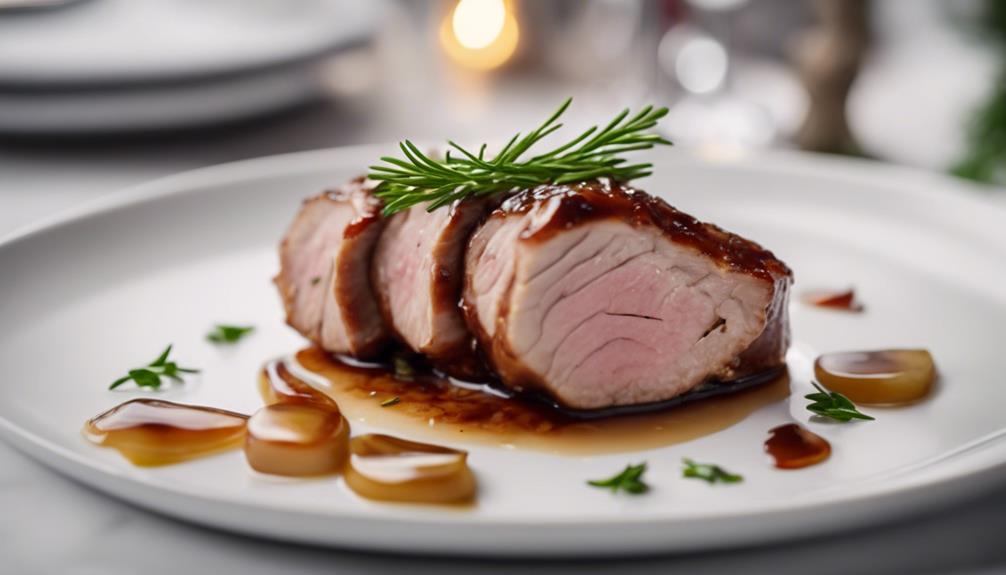
When preparing your Apple-Glazed Pork Tenderloin, consider infusing flavors with an Apple Cider Vinegar Marinade.
A Cranberry Reduction Pork Recipe can also provide a unique taste to your dish.
Or try a Pork Tenderloin Stuffed With Herbs for a different flavor profile.
These variations bring unique tastes to your dish, elevating the pork to a whole new level of deliciousness.
Experiment with these diverse recipes to find the perfect flavor profile that suits your taste preferences.
Apple Cider Vinegar Marinade
To infuse your pork tenderloin with a tangy sweetness, marinate it in a flavorful blend of apple cider vinegar and spices. This marinade not only adds depth to the taste but also helps tenderize the meat for a juicy and delicious result.
Here are three key tips for creating a delicious apple cider vinegar marinade for your pork tenderloin:
- Balanced Flavors: Combine apple cider vinegar with a touch of brown sugar, garlic, and a pinch of salt and pepper for a well-rounded marinade that balances sweetness and acidity.
- Marinating Time: Allow your pork tenderloin to marinate in the apple cider vinegar mixture for at least 2-4 hours, or ideally overnight, to let the flavors penetrate the meat fully.
- Seal in the Flavors: When marinating, make sure the pork is well coated in the marinade and enclose it in a zip-top bag or airtight container to prevent any leakage and maximize flavor absorption.
Cranberry Reduction Pork Recipe
For a delectable twist on traditional pork tenderloin, try this Cranberry Reduction Pork Recipe that combines the flavors of cranberry with the sweetness of apple glaze.
- Ingredients: Gather your pork tenderloin, cranberry sauce, apple cider vinegar, brown sugar, cloves, and cinnamon for this recipe.
- Preparation: Begin by searing the pork tenderloin on all sides in a hot skillet. Then, mix the cranberry sauce, apple cider vinegar, brown sugar, cloves, and cinnamon in a saucepan over low heat until it thickens into a rich glaze.
- Cooking: Pour the cranberry glaze over the seared pork tenderloin and bake it in the oven until the meat reaches the desired level of doneness. Baste the pork with the glaze occasionally to enhance the flavors.
This Cranberry Reduction Pork Recipe offers a delightful combination of tangy cranberry and sweet apple flavors that will elevate your pork tenderloin to a whole new level of culinary excellence.
Pork Tenderloin Stuffed With Herbs
Consider infusing your pork tenderloin with a medley of aromatic herbs to create a flavorful and succulent dish in this Apple-Glazed Pork Tenderloin Recipe.
- Selection of Herbs: Opt for a blend of fresh herbs like rosemary, thyme, and sage to impart a robust and earthy flavor to the tenderloin. These herbs complement the pork's natural taste and add depth to each bite.
- Preparing the Herb Stuffing: Finely chop the selected herbs and mix them with a touch of olive oil, garlic, salt, and pepper to form a fragrant herb paste. Spread this mixture evenly over the pork tenderloin before rolling it up for cooking.
- Cooking Technique: Roast or sous vide the herb-stuffed pork tenderloin to perfection. The cooking process allows the herbs to infuse the meat slowly, resulting in a juicy and aromatic dish. Once cooked, slice the tenderloin into rounds and serve with a drizzle of apple glaze for a delightful culinary experience.
Sous Vide Techniques
When it comes to sous vide techniques, you'll benefit from precise temperature control, ensuring your pork tenderloin cooks perfectly every time.
Additionally, the method offers even cooking distribution, guaranteeing that the entire cut is cooked to perfection.
Precise Temperature Control
To achieve perfect results when cooking sous vide, precise temperature control is essential. Sous vide cooking involves placing food in a vacuum-sealed bag and cooking it in a water bath at a precisely controlled temperature. The water temperature must be kept constant throughout the cooking process to make certain that the food cooks evenly and reaches the desired level of doneness.
Investing in a high-quality sous vide machine is vital for maintaining accurate temperature control. These devices are equipped with advanced heating elements and sensors that regulate the water temperature with precision. Additionally, using a reliable digital thermometer can help you monitor the water temperature to make sure it stays within the desired range.
Even Cooking Distribution
For consistent cooking distribution in sous vide techniques, make sure that the food is positioned evenly within the water bath to guarantee uniform results. Placing the ingredients in a single layer without overcrowding the bags helps the water to circulate efficiently, ensuring that every part of the food cooks evenly. If you stack items on top of each other, there may be uneven cooking, leading to some portions being undercooked while others are perfectly done. To prevent this, arrange the food in a way that allows water to flow around each piece freely.
Additionally, periodically rotating the bags during the cooking process can further enhance even cooking. By gently moving the bags around within the water bath, you help distribute the heat evenly, resulting in a consistent texture throughout the dish. This simple step can make a significant difference in the final outcome of your sous vide preparations. So, remember to position your food carefully and give it a gentle rotation for perfectly even cooking every time.
Retained Natural Flavors
Retaining natural flavors in your sous vide cooking is essential for preserving the authentic taste of the ingredients. When using the sous vide technique, it's important to seal your ingredients in a vacuum-sealed bag before submerging them in a precisely controlled water bath. This method not only guarantees even cooking distribution but also helps in retaining the natural juices and flavors of the pork tenderloin.
By cooking the pork tenderloin at a consistent low temperature for an extended period, the flavors have time to develop and infuse into the meat. This slow cooking process allows the meat to become tender while maintaining its natural essence. Additionally, the vacuum-sealed environment prevents any flavors from escaping, resulting in a more intense and flavorful end product.
To enhance the natural flavors further, you can add aromatics like herbs, garlic, or spices to the vacuum-sealed bag before cooking. These ingredients will complement the pork tenderloin's taste without overpowering it, creating a well-balanced and flavorful dish. By following these sous vide techniques, you can make sure that your pork tenderloin with apple glaze is bursting with delicious, retained natural flavors.
Final Thoughts
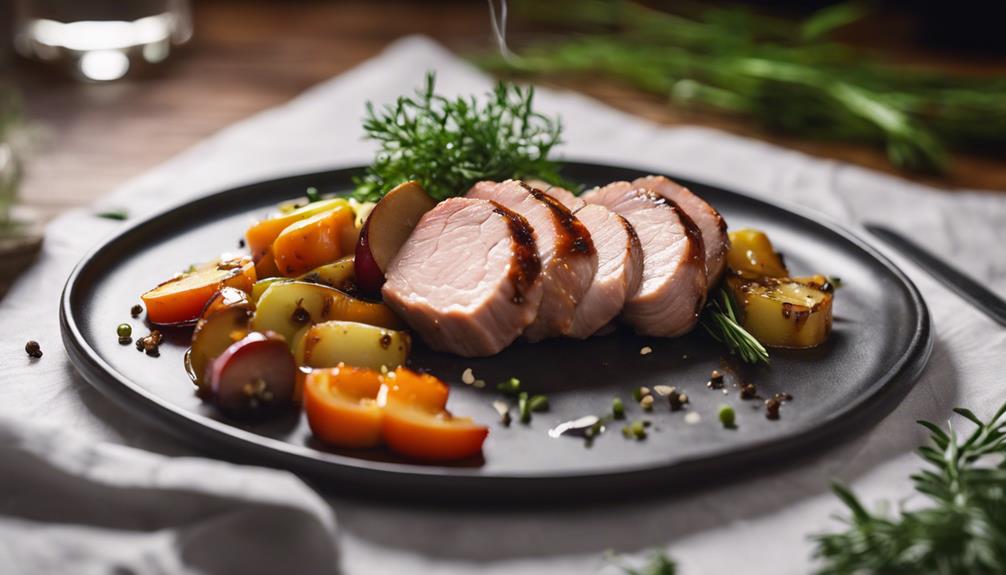
Considering the overall cooking process and flavor profile, you'll find that this Sous Vide Pork Tenderloin with Apple Glaze is a delightful dish that guarantees tenderness with a hint of sweetness. The sous vide method guarantees that the pork tenderloin is cooked to perfection, resulting in a juicy and tender texture that melts in your mouth. The apple glaze adds a layer of complexity, providing a sweet and tangy contrast to the savory pork.
One of the standout features of this dish is how the sous vide technique locks in the natural juices and flavors of the pork, enhancing its taste and tenderness. The precision of sous vide cooking assures consistent results, so you can enjoy a perfectly cooked pork tenderloin every time you make this recipe.
The apple glaze, with its combination of apple cider vinegar, brown sugar, and spices, elevates the dish to a new level. It adds a glossy finish to the pork while infusing it with a deliciously sweet and slightly tart flavor profile. The glaze complements the natural taste of the pork without overpowering it, creating a harmonious balance of flavors.
Frequently Asked Questions
Can I Use a Different Cut of Meat for This Recipe?
Yes, you can use a different cut of meat for this recipe. Just make sure the alternative cut has similar thickness and texture to pork tenderloin for best results. Experiment with cuts like pork loin or chicken breast.
How Can I Adjust the Cooking Time for a Smaller Tenderloin?
To adjust the cooking time for a smaller tenderloin, simply decrease the sous vide time. Make sure to check for doneness by using a meat thermometer. Adjusting the temperature slightly can also help achieve the desired level of doneness.
Is It Necessary to Marinate the Pork Before Sous Vide Cooking?
You don't have to marinate the pork before sous vide cooking, but it can enhance flavors. Experiment with different marinades to see what you prefer. Remember, the sous vide method already helps meat retain moisture and tenderness.
Can I Substitute the Apple Glaze With a Different Sauce?
Yes, you can substitute the apple glaze with a different sauce for your sous vide pork tenderloin. Experiment with flavors like balsamic reduction, honey mustard, or teriyaki to find a sauce that suits your taste preferences.
What Temperature Should the Water Bath Be for Sous Vide Cooking?
For sous vide cooking, set the water bath temperature to your desired doneness. Pork tenderloin usually cooks well at 140°F to 145°F. Make sure to use a reliable thermometer to maintain accuracy throughout the process.
Conclusion
To sum up, sous vide pork tenderloin with apple glaze is a delightful and flavorful dish that can be easily prepared at home using simple ingredients and techniques.
By following the steps outlined in this article, you can create a tender and juicy pork tenderloin that's sure to impress your family and friends.
Experiment with different seasoning choices and cooking times to customize the dish to your liking.
Enjoy the amazing flavors that sous vide cooking has to offer!






